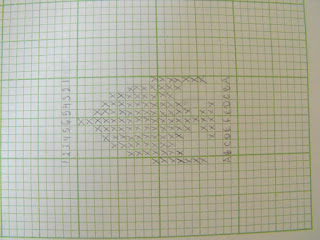I am going to use the new method for weaving Diversified Plain Weave, which is uses less shafts and has an easier treadling method.
First thing is to choose a motif; I am going to use the same angelfish from the previous two posts.
Next is the threading; looking at the angelfish motif there is vertical symmetry so again the threading will be in point order (i.e. in a V shape). Use the threading blocks for the new Diversified Plain Weave which are Block A 123 Block B 124 Block C 125 etc. The tabby shafts 1 and 2 are in a thinner grist than the pattern shafts. I used an orange colour to highlight them.
The old Diversified Plain Weave threading blocks are Block A 232141 Block B 252161 etc. There are two pattern shafts required for each block with the old style. So by using the new Diversified Plain Weave threading blocks more pattern is created using fewer shafts.
The basic tie up for the new Diversified Plain Weave is to have the first two treadles be tabby shafts versus the pattern shafts. The pattern shafts then all have shaft 1 added to them.
The old Diversified Plain Weave tie up had the first two treadles as plain weave as opposites. And the pattern shafts also had plain weave on opposites along the bottom of the treadles. This created little squares of plain weave with the thinner tabby threads and the overall fabric had a basket weave affect.
Now for the tie up, just take the graph of the angelfish and place on its side with the top of the motif facing to the left, just like for Summer and Winter. Just use the angelfish motif to create the pattern from number 6 down to 1.
Now add the pattern shafts to the basic set up. You will notice that the tie up is quite similar to Summer and Winter, although without the ‘pairs’ of pattern treadles.
For the treadling I look back at the angelfish graph and can see that each treadle corresponds to a single unit, there is no symmetry. I will place the pattern treadles in straight order (in a straight line). The treadling block for the new Diversified Plain Weave is Block A 123 Block B 124 Block C 125 etc.
The old Diversified Plain Weave treadling blocks were Block A 232 Block B 141 Block C 252 etc. While weaving it could be very easy to lose track of which tabby you were using.
The finished angelfish is 9 Shafts and 12 Treadles. There is a lot of playing around that you can do with Diversified Plain Weave, for example how big of a difference between the grists of the pattern and tabby threads do you want or do you want to highlight the thinner tabby lines or do you want to hide them? Below I thickened the pattern threads in the warp and weft.

So that’s a small guide to how to design a motif in Diversified Plain Weave. For more information about the new versus old types of Diversified Plain Weave go to Weavers Issue 36 Summer 1997, the article is called Thick ‘n Thin Again by Madelyn van der Hoogt.






No comments:
Post a Comment